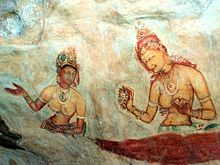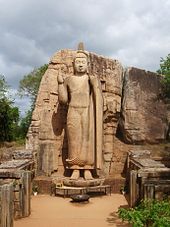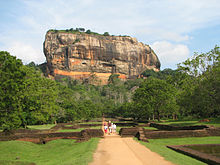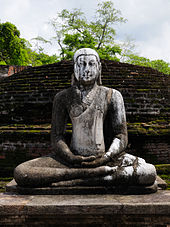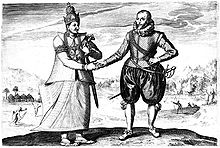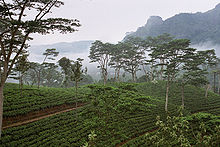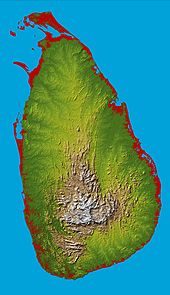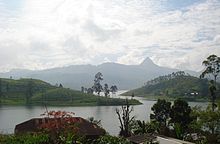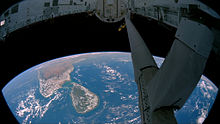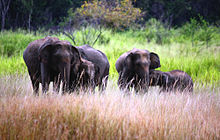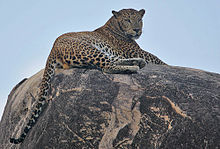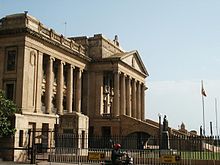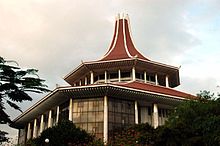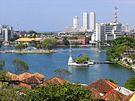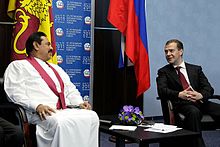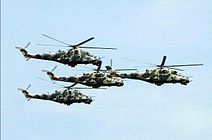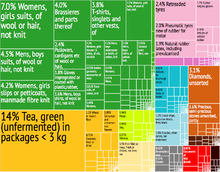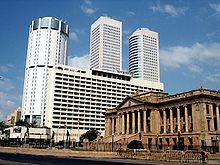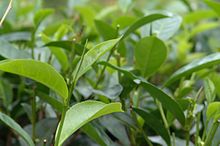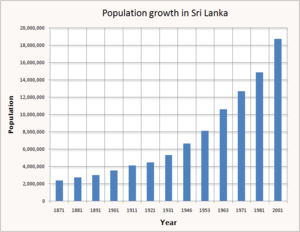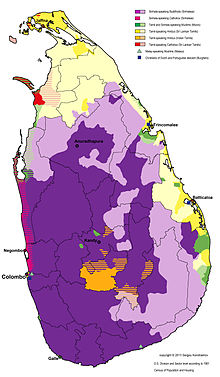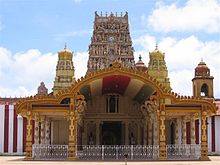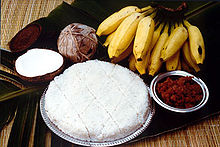
Sri Lanka
Did you know...
This wikipedia selection has been chosen by volunteers helping SOS Children from Wikipedia for this Wikipedia Selection for schools. To compare sponsorship charities this is the best sponsorship link.
| Democratic Socialist Republic of Sri Lanka ශ්රී ලංකා ප්රජාතාන්ත්රික සමාජවාදී ජනරජය
இலங்கை சனநாயக சோசலிசக் குடியரசு |
||||||
|---|---|---|---|---|---|---|
|
||||||
| Anthem: Sri Lanka Matha Mother Sri Lanka |
||||||
|
|
||||||
| Capital | Sri Jayawardenapura Kotte (official and legislature) Colombo (commercial, executive and judicial) 6°54′N 79°54′E |
|||||
| Largest city | Colombo | |||||
| Official languages |
|
|||||
| Recognized | English | |||||
| Demonym | Sri Lankan | |||||
| Government | Unitary Semi-presidential democratic socialist republic |
|||||
| - | President | Mahinda Rajapaksa | ||||
| - | Prime Minister | D. M. Jayaratne | ||||
| - | Speaker of the Parliament | Chamal Rajapaksa | ||||
| - | Chief Justice | Mohan Peiris | ||||
| Legislature | Parliament | |||||
| Independence from the United Kingdom | ||||||
| - | Dominion | 4 February 1948 | ||||
| - | Republic | 22 May 1972 | ||||
| - | Current constitution | 7 September 1978 | ||||
| Area | ||||||
| - | Total | 65,610 km2 ( 122nd) 25,332 sq mi |
||||
| - | Water (%) | 4.4 | ||||
| Population | ||||||
| - | 2012 census | 20,277,597 ( 57th) | ||||
| - | Density | 323/km2 ( 40th) 836.6/sq mi |
||||
| GDP ( PPP) | 2012 estimate | |||||
| - | Total | $127 billion ( 64th) | ||||
| - | Per capita | $6,135 ( 111th) | ||||
| GDP (nominal) | 2012 estimate | |||||
| - | Total | $64.914 billion ( 68th) | ||||
| - | Per capita | $3,139 ( 123rd) | ||||
| Gini (2010) | 36.4 medium |
|||||
| HDI (2012) | high · 92nd |
|||||
| Currency | Sri Lankan rupee ( LKR) |
|||||
| Time zone | SLST ( UTC+5:30) | |||||
| Date format | dd/mm/yyyy (AD) | |||||
| Drives on the | left | |||||
| Calling code | +94 | |||||
| ISO 3166 code | LK | |||||
| Internet TLD |
|
|||||
Sri Lanka ( / s r iː ˈ l ɑː ŋ k ə /, / s r iː ˈ l æ ŋ k ə / or / ʃ r iː ˈ l ɑː ŋ k ə /; Sinhala: ශ්රී ලංකාව, śrī laṃkāva, Tamil: இலங்கை, ilaṅkai), officially the Democratic Socialist Republic of Sri Lanka, is an island country in the northern Indian Ocean off the southern coast of the Indian subcontinent in South Asia. Known until 1972 as Ceylon ( / s ɨ ˈ l ɒ n /, / s eɪ ˈ l ɒ n /, or / s iː ˈ l ɒ n /), Sri Lanka has maritime borders with India to the northwest and the Maldives to the southwest.
Sri Lanka's documented history spans three thousand years. Its geographic location and deep harbours made it of great strategic importance from the time of the ancient Silk Road through to World War II. Sri Lanka is a diverse country home to many religions, ethnicities and languages. It is the land of the Sinhalese, Sri Lankan Tamils, Moors, Indian Tamils, Burghers, Malays, Kaffirs and the aboriginal Vedda. Sri Lanka has a rich Buddhist heritage, and the first known Buddhist writings were composed on the island. The country's recent history has been marred by a thirty-year civil war which decisively but controversially ended in a military victory in 2009.
Sri Lanka is a republic and a unitary state governed by a presidential system. The capital, Sri Jayawardenapura-Kotte, is a suburb of the largest city, Colombo. An important producer of tea, coffee, gemstones, coconuts, rubber and the native cinnamon, Sri Lanka has been called The tear drop of India because of its shape and location and is known as "The Pearl of the Indian Ocean" because of its natural beauty. It is also known as "The nation of smiling people". The island contains tropical forests, and diverse landscapes with high biodiversity.
The country has had a long history of international engagement, being a founding member of SAARC and a member of the United Nations, the Commonwealth of Nations, the G77 and the Non-Aligned Movement. It is also the only country in South Asia that is currently rated 'high' on the Human Development Index.
Etymology
In antiquity, Sri Lanka was known to travellers by a variety of names. Known in India as Lanka or Sinhala, ancient Greek geographers called it Taprobane / t ə ˈ p r ɒ b ə n iː / and Arabs referred to it as Serendib (the origin of the word " serendipity"). Ceilão was the name given to Sri Lanka by the Portuguese when they arrived in 1505, which was transliterated into English as Ceylon. As a British crown colony, the island was known as Ceylon, and achieved independence as the Dominion of Ceylon in 1948.
In Sinhala the country is known as ශ්රී ලංකා śrī laṃkā, IPA: [ʃɾiːˈlaŋkaː], and the island itself as ලංකාව laṃkāva, IPA: [laŋˈkaːʋə]. In Tamil they are both இலங்கை ilaṅkai, IPA: [iˈlaŋɡai]. In 1972, the name was changed to "Free, Sovereign and Independent Republic of Sri Lanka". In 1978 it was changed to the " Democratic Socialist Republic of Sri Lanka". The name Ceylon is still in use in the names of a number of organisations; in 2011, the Sri Lankan government announced a plan to rename all of those for which it is responsible.
History
Pre-historic
The pre-history of Sri Lanka dates back over 125 thousand years Before Present (BP) and possibly even as early as 500,000 BP. The era spans the Palaeolithic, Mesolithic and early Iron ages. Among the Paleolithic (Homo erectus) human settlements discovered in Sri Lanka, Pahiyangala (named after the Chinese traveller monk Fa-Hsien), which dates back to 37,000 BP, Batadombalena (28,500 BP) and Belilena (12,000 BP) are the most important. The remains of Balangoda Man, an anatomically modern human, found inside these caves, suggests that they may have engaged in agriculture and kept domestic dogs for driving game.
One of the first written references to the island is found in the Indian epic Ramayana, which provides details of a kingdom named Lanka that had been created by the divine sculptor Vishwakarma, for Kubera, the lord of wealth. It is said that Kubera was overthrown by his demon stepbrother Ravana, the powerful Emperor who built a mythical flying machine named Dandu Monara. The modern city of Wariyapola is described as Ravana's airport.
Early inhabitants of Sri Lanka were probably the ancestors of the Vedda people, an indigenous community living in modern-day Sri Lanka, which numbers approximately 2,500. Irish historian James Emerson Tennent theorised Galle, a southern city in Sri Lanka, was the ancient seaport of Tarshish, from which King Solomon is said to have drawn ivory, peacocks and other valuables.
Ancient
According to the Mahāvamsa, a chronicle written in Pāli language, the ancient period of Sri Lanka begins in 543 BC with the landing of Vijaya, a semi-legendary king who sailed 860 nautical miles on eight ships to Sri Lanka with 700 followers from the southwest coast of what is now the Rarh region of West Bengal. He established the Kingdom of Tambapanni, near modern day Mannar. Vijaya is the first of the approximately 189 native monarchs of Sri Lanka that the chronicles like Dipavamsa, Mahāvamsa, Chulavamsa, and Rājāvaliya describe (see List of Sri Lankan monarchs). Sri Lankan dynastic history spanned a period of 2359 years, from 543 BC to AD 1815, until the land became part of the British Empire.
The Kingdom of Sri Lanka moved to Anuradhapura in 380 BC, during the reign of Pandukabhaya. Thereafter, Anuradhapura served as the capital of the country for nearly 1400 years. Ancient Sri Lankans excelled in various constructions such as tanks, dagobas and palaces. The society underwent a major transformation during the reign of Devanampiya Tissa, with the arrival of Buddhism from India. In 250 BC, bhikkhu Mahinda (Sanskrit: महेन्द्र; Mahendra), the son of the Mauryan Emperor Ashoka arrived in Mihintale, carrying the message of Buddhism. His mission won over the monarch, who embraced the faith and propagated it throughout the Sinhalese population. The succeeding kingdoms of Sri Lanka would maintain a large number of Buddhist schools and monasteries, and support the propagation of Buddhism into other countries in Southeast Asia as well. Sri Lankan Bikkhus studied in India's famous ancient Buddhist University of Nalanda which was destroyed by Mohammed Kilji. It is probable that many of the scriptures from Nalanda are preserved in Sri Lanka's many monasteries. In 245 BC, bhikkhuni Sangamitta arrived with the Jaya Sri Maha Bodhi tree, which is considered to be a sapling from the historical Bodhi tree under which Gautama Buddha became enlightened. It is considered the oldest human-planted tree (with a continuous historical record) in the world. ( Bodhivamsa)
Sri Lanka experienced the first foreign invasion during the reign of Suratissa, who was defeated by two horse traders named Sena and Guttika from South India. The next invasion came immediately in 205 BC by a Chola king named Elara, who overthrew Asela and ruled the country for 44 years. Dutugemunu, the eldest son of the southern regional sub-king, Kavan Tissa, defeated Elara in the Battle of Vijithapura. He built Ruwanwelisaya, the second stupa in ancient Sri Lanka, and the Lovamahapaya. During its two and a half millennia of existence, the Kingdom of Sri Lanka was invaded at least eight times by neighbouring South Asian dynasties such as the Chola, Pandya, Chera, and Pallava. These invaders were all subsequently driven back. There also were incursions by the kingdoms of Kalinga (modern Odisha) and from the Malay Peninsula as well. Kala Wewa and the Avukana Buddha statue were built during the reign of Dhatusena.
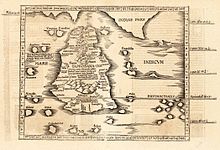
Sri Lanka was the first Asian country to have a female ruler; Queen Anula who reigned during 47–42 BC. Sri Lankan monarchs completed some remarkable constructions like Sigiriya, the so-called "Fortress in the Sky". It was built during the reign of Kashyapa I. Sigiriya is a rock fortress surrounded by an extensive network of gardens, reservoirs, and other structures. The 5th-century palace is also renowned for frescos on the rock the surface. It has been declared by UNESCO as one of the seven World Heritage Sites in Sri Lanka. Among the other constructions, large reservoirs, important for conserving water in a climate that alternates rainy seasons with dry times, and elaborate aqueducts, some with a slope as finely calibrated as one inch to the mile, are most notable. Biso Kotuwa, a peculiar construction inside a dam, is a technological marvel based on precise mathematics, allowing water to flow outside the dam keeping the pressure to a minimum. Ancient Sri Lanka was the first country in the world to have established a dedicated hospital, in Mihintale in the 4th century. It was also the leading exporter of cinnamon in the ancient world, and has maintained close ties with European civilisations including the Roman Empire. For example, King Bhatikabhaya (22 BC—AD 7) had sent an envoy to Rome who brought back red coral which was used to make an elaborate netlike adornment for the Ruwanwelisaya. In addition Sri Lankan male dancers witnessed the assassination of Caligula. When Queen Cleopatra sent her son Cesarian into hiding he was headed to Sri Lanka. i Bhikkhuni Devasāra and ten other fully ordained bhikkhunis from Sri Lanka went to China and established the bhikkhuni sāsana there in AD 429.
Medieval
The medieval period of Sri Lanka begins with the fall of Anuradhapura Kingdom. In AD 993, the invasion of Chola emperor Rajaraja I forced the then Sri Lankan ruler Mahinda V to flee to the southern part of the country. Taking advantage of this situation, Rajendra I, son of Rajaraja I, launched a large invasion in AD 1017. Mahinda V was captured and taken to India, and the Cholas sacked the city of Anuradhapura. Subsequently, they moved the capital to Polonnaruwa. This marked the end of the two great houses of dynasties of ancient Sri Lanka, the Moriya and the Lambakanna. Following a seventeen-year long campaign, Vijayabahu I successfully drove the Chola out of Sri Lanka in 1070, reuniting the country for the first time in over a century. Upon his request, ordained monks were sent from Burma to Sri Lanka to re-establish Buddhism, which had almost disappeared from the country during the Chola reign. During the medieval period, Sri Lanka was divided to three sub-territories, namely Ruhunu, Pihiti and Maya.
Sri Lanka's irrigation system was extensively expanded during the reign of Parākramabāhu the Great (AD 1153–1186). This period is considered as a time when Sri Lanka was at the height of its power. He built 1470 reservoirs – the highest number by any ruler in the history - repaired 165 dams, 3910 canals, 163 major reservoirs, and 2376 mini reservoirs. His most famous construction is the Parakrama Samudra, the largest irrigation project of medieval Sri Lanka. Parākramabāhu's reign is memorable for two major campaigns – in the south of India as part of a Pandyan war of succession, and a punitive strike against the kings of Ramanna (Myanmar) for various perceived insults to Sri Lanka.
After his demise, Sri Lanka gradually decayed in power. In AD 1215, Kalinga Magha, a South Indian with uncertain origins, identified as the founder of the Jaffna kingdom, invaded and captured the Kingdom of Polonnaruwa with a 24,000 strong army sailed 690 nautical miles on 100 large ships from Kalinga. Unlike the previous invaders, he looted, ransacked, and destroyed everything in the ancient Anuradhapura and Polonnaruwa Kingdoms beyond recovery. His priorities in ruling were to extract as much as possible from the land and overturn as many of the traditions of Rajarata as possible. His reign saw the massive migration of native Sinhalese people to the south and west of Sri Lanka, and into the mountainous interior, in a bid to escape his power. Sri Lanka never really recovered from the impact of Kalinga Magha's invasion. King Vijayabâhu III, who led the resistance, brought the kingdom to Dambadeniya. The north, in the meanwhile, eventually evolved into the Jaffna kingdom. The Jaffna kingdom never came under the rule of any kingdom of the south except on one occasion; in 1450, following the conquest led by king Parâkramabâhu VI's adopted son, Prince Sapumal. He ruled the North from AD 1450 to 1467. The next three centuries stating from 1215 were marked by kaleidoscopically shifting collections of kingdoms in south and central Sri Lanka, including Dambadeniya, Yapahuwa, Gampola, Raigama, Kotte, Sitawaka, and finally, Kandy.
Colonization
The early modern period of Sri Lanka begins with the arrival of Portuguese soldier and explorer Lourenço de Almeida, the son of Francisco de Almeida, in 1505. The Portuguese founded a fort at the port city of Colombo in 1517 and gradually extended their control over the coastal areas. In 1592 Vimaladharmasuriya I moved the kingdom to the inland city of Kandy, a location more secure against an attack from western invaders. Intermittent warfare continued through the 16th century. In 1619, due to the attacks of Portuguese, the independent existence of Jaffna kingdom came to an end.
During the reign of the Rajasinghe II, Dutch explorers arrived in the island. In 1638, the king signed a treaty with the Dutch East India Company to get rid of Portuguese who ruled most of the coastal areas. The following Dutch–Portuguese War resulted in Dutch victory, with Colombo falling into Dutch hands by 1656. The Dutch remained in the areas they captured, violating the treaty. An ethnic group named Burgher people integrated into the Sri Lankan society as a result of Dutch rule. The Kingdom of Kandy was the last independent monarchy of Sri Lanka. In 1595, Vimaladharmasurya brought the sacred Tooth Relic – the traditional symbol of royal and religious authority amongst the Sinhalese – to Kandy, and built the Temple of the Tooth. Even with intermittent warfare with Europeans, the kingdom was able to survive. A succession crisis emerged in Kandy, upon king Vira Narendrasinha's death in 1739. He was married to a Telugu-speaking Nayakkar princess from South India and was childless by her. Eventually, with the support of bhikku Weliwita Sarankara, the crown passed to the brother of one of Narendrasinha's princess, overlooking the right of "Unambuwe Bandara", Narendrasinha's own son by a Sinhalese concubine. The new king was crowned Sri Vijaya Rajasinha later that year. Kings of Nayakkar dynasty, launched several attacks on Dutch controlled areas, which proved to be unsuccessful.
During the Napoleonic Wars, fearing that French control of the Netherlands might deliver Sri Lanka to the French, Great Britain occupied the coastal areas of the island (which they called Ceylon) with little difficulty in 1796. Two years later, in 1798, Rajadhi Rajasinha, 3rd of the four Nayakkar kings of Sri Lanka died of a fever. Following the death, a nephew of Rajadhi Rajasinha, 18-year-old Konnasami was crowned. The new king, Sri Vikrama Rajasinha faced a British invasion in 1803, but was able to retaliate successfully. By then, the entire coastal area was under the British East India Company, as a result of the Treaty of Amiens. But on 14 February 1815, Kandy was occupied by the British, in the second Kandyan War, finally ending Sri Lanka's independence. Sri Vikrama Rajasinha, the last native monarch of Sri Lanka was exiled to India. The Kandyan Convention formally ceded the entire country to the British Empire. Attempts of Sri Lankan noblemen to undermine the British power in 1818 during the Uva Rebellion were thwarted by Governor Robert Brownrigg.
The beginning of the modern period of Sri Lanka is marked by the Colebrooke-Cameron reforms of 1833. They introduced a utilitarian and liberal political culture to the country based on the rule of law and amalgamated the Kandyan and maritime provinces as a single unit of government. An Executive Council and a Legislative Council were established, later becoming the foundation of representative legislature in the country. By this time, experiments with coffee plantation were largely successful. Soon it grew to become the primary commodity export of the country. The falling coffee prices as a result of the depression of 1847 stalled economic development and prompted the governor to introduce a series of taxes on firearms, dogs, shops, boats, etc., and reintroduce a form of rajakariya, requiring six days free labour on roads or payment of a cash equivalent. These harsh measures antagonised the locals, and another rebellion broke out in 1848. A devastating leaf disease, Hemileia vastatrix, struck the coffee plantations in 1869, destroying the entire industry within 15 years. The British quickly found a replacement; abandoning coffee, they began cultivating tea plantations in its stead. Tea production in Sri Lanka thrived within the decades to come. Large scale rubber plantations began in the early 20th century.
By the end of the 19th century, a new educated social class transcending race and caste arose through British attempts to staff the Ceylon Civil Service and the legal, educational, and medical professions. New leaders represented the various ethnic groups of the population in the Ceylon Legislative Council on a communal basis. Buddhist and Hindu revivalism reacted against Christian missionary activities. The first two decades in the 20th century are noted by the unique harmony among Sinhalese and Tamil political leadership, which has since been lost. In 1919, major Sinhalese and Tamil political organisations united to form the Ceylon National Congress, under the leadership of Ponnambalam Arunachalam, pressing colonial masters for more constitutional reforms. But without massive popular support, and with the governor's encouragement for "communal representation" by creating a "Colombo seat" that dangled between Sinhalese and Tamils, the Congress lost momentum towards the mid-1920s. The Donoughmore reforms of 1931 repudiated the communal representation and introduced universal adult franchise (the franchise stood at 4% before the reforms). This step was strongly criticised by the Tamil political leadership, who realised that they would be reduced to a minority in the newly created State Council of Ceylon, which succeeded the legislative council. In 1937, Tamil leader G. G. Ponnambalam demanded a 50–50 representation (50% for the Sinhalese and 50% for other ethnic groups) in the State Council. However, this demand was not met by the Soulbury reforms of 1944/45.
Independence
The Soulbury constitution ushered in Dominion status, with independence proclaimed on 4 February 1948. D. S. Senanayake became the first Prime Minister of Ceylon. Prominent Tamil leaders like Ponnambalam and Arunachalam Mahadeva joined his cabinet. The British Royal Navy remained stationed at Trincomalee until 1956. A countrywide popular demonstration against withdrawal of the rice ration, known as Hartal 1953, resulted in the resignation of prime minister Dudley Senanayake. S. W. R. D. Bandaranaike was elected prime minister in 1956. His three-year rule had a profound impact, through his self-proclaimed role of "defender of the besieged Sinhalese culture". He introduced the controversial Sinhala Only Act, recognising Sinhala as the only official language of the government. Although partially reversed in 1958, the bill posed a grave concern for the Tamil community, which perceived in it a threat to their language and culture. The Federal Party (FP) launched a movement of non-violent resistance ( satyagraha) against the bill, which prompted Bandaranaike to reach an agreement ( Bandaranaike-Chelvanayakam Pact) with S. J. V. Chelvanayakam, leader of the FP, to resolve the looming ethnic conflict. However the pact proved ineffective in the face of ongoing protests by opposition and the Buddhist clergy. The bill, together with various government colonisation schemes, contributed much towards the political rancour between Sinhalese and Tamil political leaders. Bandaranaike was assassinated by an extremist Buddhist monk in 1959.
Sirimavo Bandaranaike, the widow of late S. W. R. D. Bandaranaike, took office as prime minister in 1960, and withstood an attempted coup d'état in 1962. During her second term as prime minister, the government instituted socialist economic polices, strengthening ties with the Soviet Union and China, while promoting a policy of non-alignment. In 1971, Ceylon experienced a Marxist insurrection, which was quickly suppressed. In 1972, the country became a republic named Sri Lanka, repudiating its dominion status. Prolonged minority grievances and the use of communal emotionalism as an election campaign weapon by both Sinhalese and Tamil leaders abetted a fledgling Tamil militancy in the north, during the 1970s. The policy of standardisation by the Sirimavo government to rectify disparities created in university enrolment, which was in essence an affirmative action to assist geographically disadvantaged students to obtain tertiary education, resulted in reducing the proportion of Tamil students at university level and acted as the immediate catalyst for the rise of militancy. The assassination of Jaffna Mayor Alfred Duraiyappah in 1975 marked a crisis point.
The Government of J. R. Jayawardene swept to power in 1977, defeating the largely unpopular United Front government. Jayawardene introduced a new constitution, together with a free market economy and a powerful executive presidency modelled after that of France. It made Sri Lanka the first South Asian country to liberalise its economy. From 1983, ethnic tensions were manifested in on-and-off insurgency against the government by the Liberation Tigers of Tamil Eelam (LTTE). Following the riots in July 1983, more than 150,000 Tamil civilians fled the island, seeking asylum in other countries. Lapses in foreign policy resulted in strengthening the Tigers by providing arms and training. In 1987, the Indo-Sri Lanka Accord was signed and Indian Peace Keeping Force (IPKF) was deployed in northern Sri Lanka to stabilise the region by neutralising the LTTE. The same year, the JVP launched its second insurrection in Southern Sri Lanka, necessitating redeployment of the IPKF in 1990. In 2002, the Sri Lankan government and LTTE signed a Norwegian-mediated ceasefire agreement.
The 2004 Asian tsunami killed over 35,000 in Sri Lanka. From 1985 to 2006, Sri Lankan government and Tamil insurgents held four rounds of peace talks without success. Both LTTE and the government resumed fighting in 2006, and the government officially backed out of the ceasefire in 2008. In 2009, under the Presidency of Mahinda Rajapaksa the Sri Lanka Armed Forces defeated the LTTE, and re-established control of the entire country by the Sri Lankan Government. Overall, between 60,000 and 100,000 people were killed during the 26 years of conflict.
40,000 Tamil civilians may have been killed in the final phases of the Sri Lankan civil war, according to an Expert Panel convened by U.N. Secretary General Ban Ki-moon. The exact number of Tamils killed is still a speculation that needs further study. Following the LTTE's defeat, the Tamil National Alliance, the largest political party in Sri Lanka, dropped its demand for a separate state in favour of a federal solution. The final stages of the war left some 294,000 people displaced. According to the Ministry of Resettlement, most of the displaced persons had been released or returned to their places of origin, leaving only 6,651 in the camps as of December 2011. In May 2010, President Rajapaksa appointed the Lessons Learnt and Reconciliation Commission (LLRC) to assess the conflict between the time of the ceasefire agreement in 2002 and the defeat of the LTTE in 2009. Sri Lanka has emerged from its 26-year war to become one of the fastest growing economies of the world.
Geography
Sri Lanka lies on the Indian tectonic plate, a minor plate within the Indo-Australian Plate. It is in the Indian Ocean southwest of the Bay of Bengal, between latitudes 5° and 10°N, and longitudes 79° and 82°E. Sri Lanka is separated from the Indian subcontinent by the Gulf of Mannar and the Palk Strait. According to the Hindu mythology, a land bridge existed between the Indian mainland and Sri Lanka. It now amounts to only a chain of limestone shoals remaining above sea level. It was reportedly passable on foot up to 1480 AD, until cyclones deepened the channel.
The island consists mostly of flat-to-rolling coastal plains, with mountains rising only in the south-central part. The highest point Pidurutalagala, reaching 2,524 metres (8,281 ft) above sea level. The climate is tropical and warm, due to the moderating effects of ocean winds. Mean temperature ranges from 17 °C (62.6 °F) in the central highlands, where frost may occur for several days in the winter, to a maximum of 33 °C (91.4 °F) in other low-altitude areas. Average yearly temperature ranges from 28 °C (82.4 °F) to nearly 31 °C (87.8 °F). Day and night temperatures may vary by 14 °C (25.2 °F) to 18 °C (32.4 °F).
Rainfall pattern is influenced by monsoon winds from the Indian Ocean and Bay of Bengal. The "wet zone" and some of the windward slopes of the central highlands receive up to 2,500 millimetres (98.4 in) of rain each month, but the leeward slopes in the east and northeast receive little rain. Most of the east, southeast, and northern parts of the country comprise the "dry zone", which receives between 1,200 mm (47 in) and 1,900 mm (75 in) of rain annually. The arid northwest and southeast coasts receive the least amount of rain at 800 mm (31 in) to 1,200 mm (47 in) per year. Periodic squalls occur and sometimes tropical cyclones bring overcast skies and rains to the southwest, northeast, and eastern parts of the island. Humidity is typically higher in the southwest and mountainous areas and depends on the seasonal patterns of rainfall.
The longest of the 103 rivers in the country is Mahaweli River, covering 335 kilometres (208 mi). These waterways give rise to 51 natural waterfalls of 10 meters or more. The highest is Bambarakanda Falls, with a height of 263 metres (863 ft). Sri Lanka's coastline is 1,585 km long. It claims an Exclusive Economic Zone (EEZ) extending 200 nautical miles, approximately 6.7 times the country's land area. The coastline and adjacent waters support highly productive marine ecosystems such as fringing coral reefs, shallow beds of coastal and estuarine seagrasses. Sri Lanka inherits 45 estuaries and 40 lagoons too. Country's mangrove ecosystem which spans over 7,000 hectares, played a vital role in buffering the force in the waves of 2004 Indian Ocean tsunami. The island is rich with minerals such as Ilmenite, Feldspar, Graphite, Silica, Kaolin, Mica and Thorium. Existence of Petroleum in the Gulf of Mannar has also been confirmed and extraction attempts are underway.
Flora and fauna
Lying within the Indomalaya ecozone, Sri Lanka is one of 25 biodiversity hotspots in the world. Although the country is relatively small in size, it has the highest biodiversity density in Asia. Remarkably high proportion of the species among its flora and fauna, 27% of the 3,210 flowering plants and 22% of the mammals (see List), are endemic. Sri Lanka has declared 24 wildlife reserves, which are home to a wide range of native species such as Asian elephants, leopards, sloth bears, the unique small loris, a variety of deer, the purple-faced langur, the endangered wild boar, porcupines and anteaters.
Flowering acacias flourish on the arid Jaffna Peninsula. Among the trees of the dry-land forests are valuable species such as satinwood, ebony, ironwood, mahogany and teak. The wet zone is a tropical evergreen forest with tall trees, broad foliage, and a dense undergrowth of vines and creepers. Subtropical evergreen forests resembling those of temperate climates flourish in the higher altitudes.
The Yala National Park in the southeast protects herds of elephant, deer, and peacocks. The Wilpattu National Park, the largest, in the northwest preserves the habitats of many water birds, such as storks, pelicans, ibis, and spoonbills. The island has four biosphere reserves: Bundala, Hurulu Forest Reserve, the Kanneliya-Dediyagala-Nakiyadeniya, and Sinharaja. Out of these, Sinharaja forest reserve is home to 26 endemic birds and 20 rainforest species, including the elusive Red-faced Malkoha, Green-billed Coucal and Sri Lanka Blue Magpie. The untapped genetic potential of Sinharaja flora is enormous. Of the 211 woody trees and lianas within the reserve, 139 (66%) are endemic. The Total vegetation density, including trees, shrubs, herbs and seedlings, has been estimated at 240,000 individuals per hectare.
Sri Lanka is home to over 250 types of resident birds (see List). It has declared several bird sanctuaries including Kumana. During the Mahaweli Program of the 1970s and 1980s in northern Sri Lanka, the government set aside four areas of land totalling 1,900 km2 (730 sq mi) as national parks. However the country's forest cover, which was around 49% in 1920, had been fallen to approximately 24% by 2009.
Politics
Sri Lanka is the oldest democracy in South Asia. The Donoughmore Constitution, drafted by the Donoughmore Commission in 1931 enabled general elections with adult universal suffrage (universal adult franchise) in the country. It was the first time a non- white country within the empires of Western Europe was given one man, one vote and the power to control domestic affairs. The first election under the universal adult franchise, held in June 1931, was for the Ceylon State Council. Sir D. B. Jayatilaka was elected as the Leader of the House. In 1944, the Soulbury Commission was appointed to draft a new constitution. During this time, struggle for Independence was fought on "constitutionalist" lines under the leadership of D. S. Senanayake. The draft constitution was enacted in the same year and Senanayake was appointed as the Prime Minister from the parliamentary election in 1947. The Soulbury constitution ushered in Dominion status and Independence to Sri Lanka in 1948.
Current politics in Sri Lanka is a contest between two rival coalitions led by the centre-leftist and progressivist United People's Freedom Alliance (UPFA), an offspring of Sri Lanka Freedom Party (SLFP), and the comparatively right-wing and pro-capitalist United National Party (UNP). Sri Lanka is essentially a multi-party democracy with many smaller Buddhist, socialist and Tamil nationalist political parties. As of July 2011, the number of registered political parties in the country is 67. Out of these, the Lanka Sama Samaja Party (LSSP), established in 1935 is the oldest. UNP, established by D. S. Senanayake in 1946, was considered to be the largest single political party until recently. It is the only political group which had a representation in all parliaments since the independence. SLFP was founded by S. W. R. D. Bandaranaike, who was the Cabinet minister of Local Administration, before he left the UNP in July 1951. SLFP registered its first victory in 1956, defeating the ruling UNP in 1956 Parliamentary election. Following the parliamentary election in July 1960, Sirimavo Bandaranaike became the prime minister and the world's first elected female head of state.
G. G. Ponnambalam, the Tamil nationalist counterpart of S. W. R. D. Bandaranaike, founded the All Ceylon Tamil Congress (ACTC) in 1944. As an objection to Ponnambalam's cooperation with D. S. Senanayake, a dissident group led by S.J.V. Chelvanayakam broke away in 1949 and formed the Illankai Tamil Arasu Kachchi (ITAK) aka Federal Party. It was the main Tamil political party in Sri Lanka for next 2 decades. Federal party advocated a more aggressive stance vis-à-vis the Sinhalese. With the constitutional reforms of 1972, these parties created a common front, the Tamil United Front (later Tamil United Liberation Front). Tamil National Alliance, formed in October 2001 is the current successor of these Tamil political parties which had undergone much turbulences as Tamil militants' rise to power in late 1970s. Janatha Vimukthi Peramuna, a Marxist-Leninist political party, founded by Rohana Wijeweera in 1965, serves as the 3rd force in the current political context. It endorses radical leftist policies, with respect to the traditionalist leftist politics of LSSP and Communist Party. Founded in 1981, Sri Lanka Muslim Congress is the largest Muslim political party in Sri Lanka.
Government
| Flag | Lion Flag |
|---|---|
| Emblem | Gold Lion Passant |
| Anthem | Sri Lanka Matha |
| Butterfly | Troides darsius |
| Bird | Sri Lanka Junglefowl |
| Flower | Red and Blue Water Lily |
| Tree | Ceylon Ironwood (Nā) |
| Sport | Volleyball |
|
Source: |
|
Sri Lanka is a democratic republic and a unitary state which is governed by a semi-presidential system, with a mixture of a presidential system and a parliamentary system. It constitutes a parliamentary system governed under the constitution. Most provisions of the constitution can be amended by a two-thirds majority in parliament. However, the amendment of certain basic features such as the clauses on language, religion, and reference to Sri Lanka as a unitary state require both a two-thirds majority and approval at a nation-wide referendum.
In common with many democracies, the Sri Lankan government has three branches:
- Executive: The President of Sri Lanka is the head of state, the commander in chief of the armed forces, as well as head of government, and is popularly elected for a six-year term. In the exercise of duties, the President is responsible to the parliament. The President appoints and heads a cabinet of ministers composed of elected members of parliament. President is immune from legal proceedings while in office in respect of any acts done or omitted to be done by him either in his official or private capacity. With the 18th amendment to the constitution in 2010, the President has no term limit, which previously stood at 2.
- Legislative: The Parliament of Sri Lanka, is a unicameral 225-member legislature with 196 members elected in multi-seat constituencies and 29 by proportional representation. Members are elected by universal (adult) suffrage based on a modified proportional representation system by district to a six-year term. The president may summon, suspend, or end a legislative session and dissolve Parliament any time after it has served for one year. The parliament reserves the power to make all laws. President's deputy, the Prime Minister, leads the ruling party in parliament and shares many executive responsibilities, mainly in domestic affairs.
- Judicial: Sri Lanka's judiciary consists of a Supreme Court – the highest and final superior court of record, a Court of Appeal, High Courts and a number of subordinate courts. Its highly complex legal system reflects diverse cultural influences. The Criminal law is almost entirely based on British law. Basic Civil law relates to the Roman law and Dutch law. Laws pertaining to marriage, divorce, and inheritance are communal. Due to ancient customary practices and/or religion, the Sinhala customary law (Kandyan law), the Thesavalamai and the Sharia law too are followed on special cases. The President appoints judges to the Supreme Court, the Court of Appeal, and the High Courts. A judicial service commission, composed of the Chief Justice and two Supreme Court judges, appoints, transfers, and dismisses lower court judges.
Administrative divisions
Mannar
Province
Province
Province
Province
Province
For administrative purposes, Sri Lanka is divided into 9 provinces and 25 districts.
- Provinces
Provinces ( Sinhala: පළාතTamil: மாகாணம்) have existed in Sri Lanka since the 19th century. But they didn't have any legal status until 1987 when the 13th Amendment to the 1978 Constitution of Sri Lanka established provincial councils following several decades of increasing demand for a decentralisation of the Government of Sri Lanka. The provincial council is an autonomous body and is not under any Ministry. It undertakes activities which had earlier been undertaken by the Central Government Ministries, Departments, Corporations and Statutory Authorities. But importantly, land and police authorities are not given to provincial councils in practice. Between 1988 and 2006, the Northern and Eastern provinces were temporarily merged to form the North-East Province. Prior to 1987, all administrative tasks were handled by a district-based civil service which had been in place since colonial times. Now each province is administered by a directly elected provincial council:
| Administrative Divisions of Sri Lanka | |||||||
|---|---|---|---|---|---|---|---|
| Province | Capital | Area (km²) | Area (sq mi) |
Population | |||
| Central | Kandy | 5,674 | 2,191 | 2,556,774 | |||
| Eastern | Trincomalee | 9,996 | 3,859 | 1,547,377 | |||
| North Central | Anuradhapura | 10,714 | 4,137 | 1,259,421 | |||
| Northern | Jaffna | 8,884 | 3,430 | 1,060,023 | |||
| North Western | Kurunegala | 7,812 | 3,016 | 2,372,185 | |||
| Sabaragamuwa | Ratnapura | 4,902 | 1,893 | 1,919,478 | |||
| Southern | Galle | 5,559 | 2,146 | 2,465,626 | |||
| Uva | Badulla | 8,488 | 3,277 | 1,259,419 | |||
| Western | Colombo | 3,709 | 1,432 | 5,837,294 | |||
- Districts and local authorities
Sri Lanka is also divided into 25 districts ( Sinhala: දිස්ත්රික්ක sing. දිස්ත්රික්කයTamil: மாவட்டம்). Each district is administered under a District Secretariat. The districts are further subdivided into 256 divisional secretariats, and these in turn, to approximately 14,008 Grama Niladhari divisions. The Districts are known in Sinhala as Disa and in Tamil as Māwaddam. Originally a Disa (usually rendered into English as Dissavony) was a duchy, notably Matale and Uva. The Government Agent, who is known as District Secretary, administers a district.
There are three other types of local authorities: Municipal Councils (18), Urban councils (13) and Pradeshiya Sabha (aka Pradesha Sabhai, 256). Local authorities were originally based on the feudal counties named korale and rata, and were formerly known as 'D.R.O. divisions' after the 'Divisional Revenue Officer'. Later the D.R.O.s became 'Assistant Government Agents' and the divisions were known as 'A.G.A. divisions'. These Divisional Secretariats are currently administered by a 'Divisional Secretary'.
| Largest cities of Sri Lanka (2010 Department of Census and Statistics estimate) |
|||||||||||
|---|---|---|---|---|---|---|---|---|---|---|---|
|
|
Rank | City Name | Province | Pop. | Rank | City Name | Province | Pop. | |||
| 1 | Colombo | Western | 752,933 | 11 | Batticaloa | Eastern | 92,332 | ||||
| 2 | Dehiwala-Mount Lavinia | Western | 245,974 | 12 | Jaffna | Northern | 88,138 | ||||
| 3 | Moratuwa | Western | 207,755 | 13 | Katunayake | Western | 76,816 | ||||
| 4 | Kotte | Western | 135,806 | 14 | Dambulla | Central | 68,821 | ||||
| 5 | Negombo | Western | 127,754 | 15 | Kolonnawa | Western | 64,887 | ||||
| 6 | Kandy | Central | 125,351 | 16 | Anuradhapura | North Central | 63,208 | ||||
| 7 | Kalmunai | Eastern | 106,783 | 17 | Embilipitiya | Sabaragamuwa | 58,371 | ||||
| 8 | Vavuniya | Northern | 99,653 | 18 | Ratnapura | Sabaragamuwa | 52,170 | ||||
| 9 | Galle | Southern | 99,478 | 19 | Badulla | Uva | 47,587 | ||||
| 10 | Trincomalee | Eastern | 99,135 | 20 | Matara | Southern | 47,420 | ||||
Foreign relations and the military
Sri Lanka is a founding member of the Non-Aligned Movement (NAM). It has cultivated relations with India while avoiding sacrificing independence. It became a member of the United Nations in 1955. Sri Lanka is also a member of the Commonwealth, the SAARC, World Bank, International Monetary Fund, Asian Development Bank and the Colombo Plan.
One of the two parties that have governed Sri Lanka since its independence, United National Party, traditionally favours links with the West, while its left-leaning counterpart, Sri Lanka Freedom Party favours links to the East. Sri Lankan Finance Minister J. R. Jayewardene, together with the then Australian Foreign Minister Sir Percy Spencer, proposed the Colombo Plan at Commonwealth Foreign Minister's Conference held in Colombo in 1950. Sri Lanka argued for a free Japan, while many countries were reluctant, at the San Francisco Peace Conference in 1951, and refused to accept Japanese payment of reparations for that World War II damage because it would harm Japan's economy. Sri Lanka-China relations started as soon as the PRC was formed in 1949. Two countries signed an important Rice-Rubber Pact in 1952. Sri Lanka played a vital role in Asian–African Conference in 1955, which was an important step toward the crystallisation of the NAM.
The Bandaranaike government of 1956 significantly changed the pro-western policies set by the previous UNP government. It recognised the new Cuba under Fidel Castro in 1959. Shortly after, Cuba's revolutionary Ernesto Che Guevara paid a visit to Sri Lanka. The Sirima- Shastri Pact of 1964 and Sirima-Gandhi Pact of 1974 were signed between Sri Lankan and Indian leaders in an attempt to solve the long standing dispute over the status of plantation workers of Indian origin. In 1974, Kachchatheevu, a small island in Palk Strait was formally ceded to Sri Lanka. By this time, Sri Lanka was strongly involved in the NAM and Colombo held the fifth NAM summit of 1976. The relationship between Sri Lanka and India became tensed under the government of J. R. Jayawardene. As a result, India intervened in Sri Lankan Civil War and subsequently deployed the Indian Peace Keeping Force in 1987. In the present, Sri Lanka enjoys extensive relations with China, Russia and Pakistan.
The Sri Lanka Armed Forces, comprising the Sri Lanka Army, the Sri Lanka Navy and the Sri Lanka Air Force, comes under the purview of the Ministry of Defence (MoD). The total strength of the three services is around 259,000 personnel, with nearly 36,000 reserves. Sri Lanka has not enforced military conscription. Paramilitary units include the Special Task Force, the Civil Security Force and the Sri Lanka Coast Guard
Since independence in 1948, the primary focus of the armed forces has been internal security, crushing three major insurgencies, two by Marxist militants of the JVP and a 30-year long conflict with the LTTE which has been proscribed as a terrorist organisation by 32 countries. The armed forces has thereby expanded to its current size and are in a continuous mobilised state for the last 30 years. Marking a rare occurrence in modern military history, Sri Lankan military was able to bring a decisive end to the Sri Lankan Civil War in May 2009. Sri Lanka claimed itself the first country in the modern world to eradicate terrorism on its own soil. Sri Lankan Armed Forces have engaged in United Nations peacekeeping operations since the early 1960s. It has contributed with forces as permanent contingents deployed in several UN peacekeeping missions in Chad, Lebanon and Haiti.
Economy
According to the International Monetary Fund, Sri Lanka has a yearly gross domestic output of US$59 billion as of 2010. It has a GDP of US$116 billion in terms of purchasing power parity. Sri Lanka is next only to Maldives in the South Asian region in terms of per capita income, with a nominal value of US$2,877 and PPP value of US$5,673. It recorded a GDP growth of 8.3% in 2011.
In the 19th and 20th centuries, Sri Lanka became a plantation economy, famous for its production and export of cinnamon, rubber and Ceylon tea, which remains a trademark national export. The development of modern ports under British rule raised the strategic importance of the island as a centre of trade. From 1948 to 1977 socialism strongly influenced the government's economic policies. Colonial plantations were dismantled, industries were nationalised and a welfare state established. In 1977 the Free market economy was introduced to the country, incorporating privatisation, deregulation and the promotion of private enterprise.
While the production and export of tea, rubber, coffee, sugar and other commodities remain important, industrialisation has increased the importance of food processing, textiles, telecommunications and finance. Main economic sectors of the country are tourism, tea export, clothing, rice production and other agricultural products. In addition to these economic sectors, overseas employment contributes highly in foreign exchange, most of them from the Middle East. As of 2010, the service sector makes up 60% of GDP, the industrial sector 28% and the agriculture sector 12%. The private sector accounts for 85% of the economy. India is the largest trading partner of Sri Lanka. Economic disparies exist between the provinces, with Western province contributing to 45.1% of the GDP, Southern province and Central province, 10.7% and 10% respectively. With the end of the war, Northern province reported a record 22.9% GDP growth in 2010.
The per capita income of Sri Lanka has doubled since 2005. During the same period, poverty has dropped from 15.2% to 7.6%, unemployment has dropped from 7.2% to 4.9%, market capitalisation of CSE has quadrupled and budget deficit has doubled. 90% of the households in Sri Lanka are electrified, 87.3% of the population have access to safe drinking water and 39% have access to pipe-borne water. Income inequality has also dropped in recent years, indicated by a gini coefficient of 0.36 in 2010. Sri Lanka's cellular subscriber base has shown a staggering 550% growth, from 2005 to 2010. Sri Lanka was the first country in the South Asian region to introduce 3G (Third Generation), 3.5G HSDPA, 3.75G HSUPA and 4G LTE mobile broadband Internet technologies.
The Global Competitiveness Report published by the World Economic Forum has listed Sri Lanka as a transitive economy, from factor-driven stage to efficiency-driven stage, ranking 52nd in the global competitiveness. It also ranked 45th in health and primary education, 32nd in business sophistication, 42nd in innovation and 41st in goods market efficiency out of the 142 countries surveyed. Sri Lanka ranks 8th in the World Giving Index, registering high levels of contentment and charitable behaviour in its society. In 2010, The New York Times placed Sri Lanka at number 1 position in 31 places to visit. Dow Jones classified Sri Lanka as an emerging market in 2010, and Citigroup classified it as a 3G country in February 2011. Sri Lanka ranks well above other South Asian countries in Human Development Index (HDI) with 0.715 points.
Although poverty has reduced by 50% during last 5 years, malnutrition remains a problem among children. 29% of the children under 5 years of age are reported to be underweight. Nearly 58% of infants between 6 and 11 months and 38% of children between 12 and 23 months are anaemic. While Dengue remains the major infectious disease, non-communicable diseasees (NCDs) account for 85% of ill health, disability and early death in Sri Lanka. Sri Lankans have a life expectancy of 77.9 years at birth, which is 10% higher than the world average. Infant mortality rate stands at 8.5 per 1000 births and maternal mortality rate at 0.39 per 1000 births, which is in par with figures of the developed countries. The universal, "pro-poor" health care system adopted by the country has contributed much towards these figures.
Sri Lanka's road network consists of 35 A grade highways and 1 Controlled-access highway ( E01). The railway network, operated by the state-run national railway operator, Sri Lanka Railways, spans 1,447 kilometres (900 mi). Sri Lanka also has three deep-water ports, at Colombo, Galle, and Trincomalee, in addition to the newest port being built at Hambantota. The Trincomalee port is the fifth largest natural harbour in the world. During world war 2 the British stated they could place their entire navy in Trincomalee with room to spare. Its flag carrier airline is the SriLankan Airlines. Fitch Ratings has affirmed Sri Lanka's Foreign- and Local-Currency Issuer Default Ratings (IDRs) at 'BB-' with a "stable" outlook.. With a grant of 20 million dollars from the US and the help from China a space academy has been set up for the purpose of developing an indigenous space sector to launch satellites of other nations as well as for domestic use. The dual use of launching technology will also serve to develop missile technology. On 26 September 2012 China launched Sri Lanka's first satellite with intentions of more launches in the coming years.
Demographics
Sri Lanka is the 53rd most populated nation in the world, with an annual population growth rate of 0.73%. Sri Lanka has a birth rate of 17.6 births per 1,000 people and a death rate of 6.2 deaths per 1,000 people. Population density is highest in western Sri Lanka, especially in and around the capital. Sinhalese constitute the largest ethnic group in the country, with 74.88% of the total population. Sri Lankan Tamils are the second major ethnic group in the island, with a percentage of 11.2. Sri Lankan Moors comprise 9.2%. Tamils of Indian origin were brought into the country as indentured labourers by British colonists to work on estate plantations. Nearly 50% of them were repatriated following independence in 1948. They are distinguished from the native Tamil population that has resided in Sri Lanka since ancient times. There are also small ethnic groups such as the Burghers (of mixed European descent) and Austronesian peoples from Southeast Asia. Moreover, there is a small population of Vedda people who are believed to be the original indigenous group to inhabit the island.
Sinhalese and Tamil are the two official languages of Sri Lanka. The Constitution defines English as the link language. English is widely used for education, scientific and commercial purposes. Members of the Burgher community speak variant forms of Portuguese Creole and Dutch with varying proficiency, while members of the Malay community speak a form of Creole Malay that is unique to the island.
Sri Lanka is also a multi-religious country. 70% are Buddhists, most of whom follow the Theravada school of Buddhism. Buddhism was introduced to Sri Lanka in the 2nd century BCE by Venerable Mahinda. A sapling of the Bodhi Tree under which the Buddha attained enlightenment was brought to Sri Lanka during the same time. The Pali Canon (Thripitakaya), having previously been preserved as an oral tradition, was first committed to writing in Sri Lanka around 30 BCE. Sri Lanka has the longest continuous history of Buddhism of any predominately Buddhist nation, with the Sangha having existed in a largely unbroken lineage since its introduction in the 2nd century BCE. During periods of decline, the Sri Lankan monastic lineage was revived through contact with Thailand and Burma. Buddhism is given special recognition in the Constitution which requires Sri Lankan to "protect and foster the Buddha Sasana".
Hinduism is the second most prevalent religion in Sri Lanka and predates Buddhism. Today, Hinduism is dominant in Northern, Eastern and Central Sri Lanka.
Islam is the third most dominant religion in the country, having first been brought to the island by Arab traders, over the course of many centuries, starting around the 7th century A.D. Most Muslims are Sunni who follow the Shafi'i school. Most followers of Islam in Sri Lanka today are believed to be descendants of these Arab traders and the local women they married.
Christianity was also brought into the country by Western colonists in the early 16th century. Around 7.4% of the Sri Lankan population are Christians. Out of those, 82% are Roman Catholics, who trace their religious heritage directly to the Portuguese. The rest of the Christians are evenly split between the Anglican Church of Ceylon and other Protestant faiths. There is also a small population of Zoroastrian immigrants from India ( Parsis) who settled in Ceylon during the period of British rule. But the community has steadily dwindled in recent years. Religion plays a prominent role in the life and culture of Sri Lankans. The Buddhist majority observe Poya Days, once per month according to the Lunar calendar. The Hindus and Muslims also observe their own holidays. Sri Lanka was ranked the 3rd most religious country in the world by a 2008 Gallup poll, with 99% of Sri Lankans saying religion is an important part of their daily life.
Culture
The culture of Sri Lanka dates back over 2500 years. It is influenced primarily by Buddhism and Hinduism. According to Islamic folklore, Adam and Eve were offered refuge on the island as solace for their expulsion from the Garden of Eden. The island is the home to two main traditional cultures: the Sinhalese (centred in the ancient cities of Kandy and Anuradhapura) and the Tamil (centred in the city of Jaffna). In more recent times, the British colonial culture has also influenced the locals. Sri Lanka claims a democratic tradition matched by few other developing countries.
The first Tamil immigration was probably around the 3rd century BC. Tamils co-existed with the Sinhalese people since then, and the early mixing rendered the two ethnic groups almost physically indistinct. Ancient Sri Lanka is marked for its genius in hydraulic engineering and architecture. The rich cultural traditions shared by all Sri Lankan cultures is the basis of the country's long life expectancy, advanced health standards and high literacy rate.
Food and festivals
Dishes include rice and curry, pittu, Kiribath, wholemeal Roti, String hoppers, wattalapam (a rich pudding of Malay origin made of coconut milk, jaggery, cashew nuts, eggs, and spices including cinnamon and nutmeg), kottu, and hoppers. Jackfruit may sometimes replace rice and curries. Traditionally food is served on a plantain leaf.
Middle Eastern influences and practices are found in traditional Moor dishes, while Dutch and Portuguese influences are found with the island's Burgher community preserving their culture through traditional dishes such as Lamprais (rice cooked in stock and baked in a banana leaf), Breudher (Dutch Christmas cake), Bolo Fiado (Portuguese-style layer cake), and Gum Billas (Dutch style honey coated sweet treats).
In April, Sri Lankans celebrate the Buddhist and Hindu new year festival. In addition, Esala Perahera, a symbolic Buddhist festival consisting of dances and richly decorated elephants, is held in Kandy, during the month of August. Fire-dances, whip-dances, Kandian dances and various other cultural dances are integral parts of the festival. Tamils celebrate Thai Pongal, Maha Shivaratri and Muslims celebrate Hajj, Ramadan in their respective days of the year.
Visual, literary and performing arts
The movie Kadawunu Poronduwa (The broken promise), produced by S. M. Nayagam of Chitra Kala Movietone, heralded the coming of Sri Lankan cinema in 1947. Ranmuthu Duwa (Island of treasures, 1962) marked the transition cinema from black-and-white to colour. It in the recent years has featured subjects such as family melodrama, social transformation and the years of conflict between the military and the LTTE. Their cinematic style is similar to the Bollywood movies. In 1979, movie attendance rose to an all-time high, but has been in steady decline since then. Undoubtedly the most influential and revolutionary filmmaker in the history of Sri Lankan cinema is Lester James Peiris, who has directed a number of movies which led to global acclaim, including Rekava (Line of destiny, 1956), Gamperaliya (The changing village, 1964), Nidhanaya (The treasure, 1970) and Golu Hadawatha (Cold heart, 1968).
The earliest music in Sri Lanka came from theatrical performances such as Kolam, Sokari and Nadagam. Traditional music instruments such as Béra, Thammátama, Daŭla and Răbān were performed at these dramas. The first music album, Nurthi, was released through Radio Ceylon, in 1903. Songwriters like Mahagama Sekara and Ananda Samarakoon and musicians such as W. D. Amaradeva, H. R. Jothipala and Clarence Wijewardene have contributed much towards the upliftment of Sri Lankan music. Baila is another popular music genre in the country, originated among Kaffirs or the or Afro-Sinhalese community.
There are three main styles of Sri Lankan classical dance. They are, the Kandyan dances, low country dances and Sabaragamuwa dances. Out of these, the Kandyan style, which flourished under kings of the Kingdom of Kandy, is more prominent. It is a sophisticated form of dance, that consists of five sub-categories: Ves dance, Naiyandi dance, Udekki dance, Pantheru dance and 18 Vannam. An elaborate headdress is worn by the male dancers and a drum called Geta Béraya is used to assist the dancer to keep on rhythm. In addition, four folk drama variants named Sokri, Kolam, Nadagam, Pasu, and several devil dance variants such as Sanni Yakuma and Kohomba Kankariya can be also observed.
The history of Sri Lankan painting and sculpture can be traced as far back as to the 2nd or 3rd century BC. The earliest mention about the art of painting on Mahavamsa, is to the drawing of a palace on cloth using cinnabar in the 2nd century BC. The chronicles have description of various paintings in relic-chambers of Buddhist stupas, and in monastic residence.
Theatre moved into the country when a Parsi company from Mumbai introduced Nurti, a blend of European and Indian theatrical conventions to the Colombo audience in 19th century. The golden age of Sri Lankan drama and theatre began with the staging of Maname, a play written by Ediriweera Sarachchandra in 1956. It was followed by a series of popular dramas like Sinhabāhu, Pabāvatī, Mahāsāra, Muudu Puththu and Subha saha Yasa.
Sri Lankan literature spans at least two millennia, and is heir to the Aryan literary tradition as embodied in the hymns of the Rigveda. The Pāli Canon, the standard collection of scriptures in the Theravada Buddhist tradition, was written down in Sri Lanka during the Fourth Buddhist council, at the Alulena cave temple, Kegalle, as early as 29 BC. Ancient chronicles such as Mahāvamsa, which was written in 6th century provide vivid descriptions of Sri Lankan dynasty. According to the German philosopher Wilhelm Geiger, the chronicles are based on Sinhala Atthakatha (commentary), that dates few more centuries back. The oldest surviving prose work is the Dhampiya-Atuva-Getapadaya, compiled in the 9th century. The greatest literary feats of medieval Sri Lanka include Sandesha Kāvya (poetic messages) such as Girā Sandeshaya (Parrot message), Hansa Sandeshaya (Swan message) and Salalihini Sandeshaya (Myna message). Poetry including Kavsilumina, Kavya-Sekharaya (diadem of poetry) and proses such as Saddharma-Ratnāvaliya, Amāvatura (Flood of nectar) and Pujāvaliya are also notable works of this period, which is considered to be the golden age of Sri Lankan literature. The first modern-day novel, Meena, a work of Simon de Silva appeared in 1905, and was followed by a number of revolutionary literary works. Martin Wickramasinghe, the author of Madol Doova is considered the iconic figure of Sri Lankan literature.
Education
With a literacy rate of 92.5%, Sri Lanka has one of the most literate populations amongst developing nations. Its youth literacy rate stands at 98%, computer literacy rate at 35%, and primary school enrolment rate at over 99%. An education system which dictates 9 years of compulsory schooling for every child is in place. The free education system established in 1945, is a result of the initiative of C. W. W. Kannangara and A. Ratnayake. It is one of the few countries in the world that provide universal free education from primary to tertiary stage.
Kannangara led the establishment of the Madhya Maha Vidyalayas (Central Schools) in different parts of the country in order to provide education to Sri Lanka's rural children. In 1942 a special education committee proposed extensive reforms to establish an efficient and quality education system for the people. However in the 1980s changes to this system saw the separation the of administration of schools between the central government and the provincial government. Thus the elite National Schools are controlled directly by the Ministry of Education and the provincial schools by the provincial government. Sri Lanka has approximately 9675 government schools, 817 private schools and Pirivenas. The number of public universities in Sri Lanka is 15. However, lack of responsiveness of the education system to labour market requirements, disparities in access to quality education, lack of an effective linkage between secondary and tertiary education remain major challenges for the education sector. A number of private, degree awarding institutions have emerged in recent times to fill in these gaps. But still, the participation at tertiary level education hovers around 5.1%. The proposed private university bill has been withdrawn by the Higher Education Ministry after university students’ heavy demonstrations and resistance.
The British science fiction author Arthur C. Clarke (most famous as the author of 2001 A Space Odyssey) served as Chancellor of Moratuwa University in Sri Lanka from 1979 to 2002.
Sports

While the national sport in Sri Lanka is volleyball, by far the most popular sport in the country is cricket. Rugby union also enjoys extensive popularity, as do athletics, football (soccer) and tennis. Sri Lanka's schools and colleges regularly organise sports and athletics teams, competing on provincial and national levels.
The Sri Lanka national cricket team achieved considerable success beginning in the 1990s, rising from underdog status to winning the 1996 Cricket World Cup. They also became the runners up of the Cricket World Cup in 2007, 2011. and of the ICC World Twenty20 in 2009 and 2012. Former Sri Lankan off-spinner, Muttiah Muralitharan has been rated as the greatest Test match bowler ever by Wisden Cricketers' Almanack. Sri Lanka has won the Asia Cup in 1986, 1997, 2004 and 2008. Current world records for highest team score in all three formats of the game are also held by Sri Lanka. The country co-hosted the Cricket World Cup in 1996, 2011 and have hosted the 2012 ICC World Twenty20. They lost to the West Indies by 36 runs.
Sri Lankans have won two medals at Olympic Games, one silver, by Duncan White at 1948 London Olympics for men's 400 metres hurdles and one silver by Susanthika Jayasinghe at 2000 Sydney Olympics for women's 200 metres. In 1973, Mohammed Lafir won the World Billiards Championship, highest feat of a Sri Lankan in a Cue sport. Aquatic sports such as boating, surfing, swimming, kitesurfing and scuba diving on the coast, the beaches and backwaters attract a large number of Sri Lankans and foreign tourists. There are two styles of martial arts native to Sri Lanka, Cheena di and Angampora.



